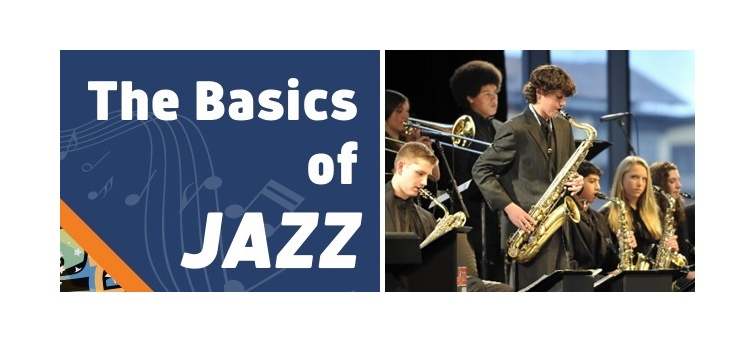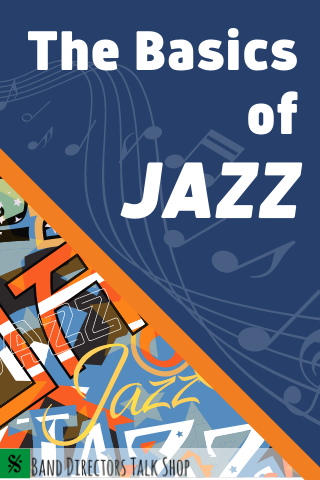
The Basics of Jazz
Curated from Band Directors Talk Shop –
For many, learning to play jazz can be daunting, much less trying to teach it. Students know what good jazz sounds like, but how do you relay it to others? It doesn’t help that the notation does not always represent what is actually happening. To help your students, there are a few things you need to understand, and this article will guide you through them. These elements include Basic Swing, Bebop Tonguing, and the “Rules of Jazz.”

BASIC SWING
The foundation of jazz is Swing (“It Don’t Mean A Thing If It Ain’t Got That Swing”). Swing can mean several things, but for our purposes, when we talk about swing, we will be talking about swing eighth-notes.
In effect, playing jazz is like playing 12/8. Swing eighths can be broken down into: [example 1.1 swing eighths vs. triplets]

The top two staves are what swing eighths would look like if notated the way they are played, with the bottom staff showing the way it looks on the page.
When people learn to swing, one of the first obstacles they encounter is the discrepancy between the way the notes look and the way they sound. Below in Example 1.2, is notated how an F scale looks and what it would look if the notation reflected the way it sounds. Notice how they look different than they sound.

There are more elements to swinging than just this, but it is the first step – seeing the notes one-way, and playing them another. It may help if, at first, you think of jazz being in 12/8. It takes a little getting used to, but with some practice, you can easily make the adjustment.
Keeping swing smooth is very important for several reasons. First, fluidity is needed to help propel the lines. It is easier to play fast lines when things are smooth. Second, it creates a striking contrast when angularity is added through the melodic line.
Have your students practice their scales in swing style, slurring them as they play. [Example 1.3] Slurring will help keep the rhythm smooth, which is essential and will be discussed further in the next chapter. The goal is to make it sound and feel natural. Also, playing scales with a swing feel is a great change of pace when practicing!

Listening to the drums, specifically the ride cymbal, will help when playing. A good drummer makes swinging easy by giving you a good swing feel. By focusing and matching the feel of the rhythm section will help you keep things relaxed.
BEBOP TONGUING
If you’ve experimented with swing eighths, you noticed that while it sounds okay, something is missing. It is at this point that separates the hip from the others. This is also where misleading information can occur.
One of the biggest misconceptions is that in order to swing, you should put accents on every up-beat.

The notes are in the swing style, but it does not sound quite right. All the accents unfortunately destroy any smoothness that you create. So, it is not right with the accents, but it is not right totally slurred: something is left out.
What is absent is Bebop Tonguing. Put simply, the key to swinging authentically is Bebop Tonguing. In Bebop Tonguing, you tongue the upbeat and slur to the downbeat. [Example 2.2] This style of articulation is not notated in the music; the player is expected to know to use Bebop Tonguing automatically. Because of its importance and “secretive” nature, you could consider Bebop Tonguing one of the secrets of jazz.

When applying the slurs, you have to be careful not to make the ends of them (the downbeats) short. While this may be common in classical music, it is not appropriate for jazz. In order to keep the smoothness need for swing, the downbeats need to be legato.
One way to keep things in perspective is to re-examine swing eighths. Look back at the two notes of a beat in example 1.1. Notice that relationship: the downbeat is twice as long as the upbeat. This is a good reminder to keep the ends of the slurs long.
Along with the misguided accents, the other common mistake is to clip the ends of the slurs. When the ends of the slurs are played short, it causes the swing to sound “hokey.”
Since we try to keep things smooth, the tongue on the upbeats creates a contrast, which is often mistaken for accents. The effect of Bebop Tonguing should just be an interruption of the legato line. When practicing Bebop Tonguing, slur the whole passage first, then add the tongue on the repeat: the two should sound and feel very similar.
This is a huge obstacle when first learning to play jazz. When the tongue is added, the tendency is to heavily accent it. Lighten up on the tongue attack. Use a “da’ syllable to keep things relaxed sounding. Remember, there should be no difference in the air-stream between slurring and Bebop Tonguing.
Bebop Tonguing even applies to pieces where everything is slurred. There was a period when publishers marked everything to make sure that the passages were played legato and smooth.
RULES OF JAZZ
As jazz evolved through time, certain “rules” developed as to how jazz should sound. These rules were not written down or stated in any fashion. Players learned them by listening and mimicking other players. These stylistic idiosyncrasies create what I call “The Rules of Jazz.” As with Bebop Tonguing, these are not generally marked in the music; it is expected that the player is familiar with these. By following these guidelines, your students will be on their way to sounding and playing like true jazz players!
Since jazz was not written down but passed down aurally, not all players will employ all of the rules. In fact, due to the wide variance in individual playing styles and interpretations, there are some that do not follow any of the rules. It is these differences in approach that make jazz so personal and exciting! But, by employing these guidelines, they will be able to blend in and play in any setting.
Rule #1: All Eighths are Legato Unless Marked Otherwise
This goes back to the idea that swing needs to be smooth. By playing all eighths long, this eliminates any “hokeyness.” Proper use of Bebop Tonguing helps keep things smooth. Play through Example 3.1, making sure to keep things legato. If they are having trouble with keeping things smooth, have them go back and slur the passage to reacquaint themselves with how it sounds legato.
Playing jazz should feel easy. If it seems uncomfortable, focus on keeping things legato. Generally, if they make things smooth and legato (especially if they are using Bebop Tonguing), everything will be okay.
If the composer/arranger wants to make an exception and have the eighths short, they will mark it in the part (finally, something notated!) to make sure there is no misunderstanding. (This pertains to our friend UMO – Unless Marked Otherwise)

Rule #2: All Quarter Notes are Short Unless Marked Otherwise
Similar to all eighths legato, all quarter notes are short. Short in jazz is not the same as short in Classical. In Classical, short means “as short as possible,” where in jazz it means “shorter than normal but with weight or attitude.”
The syllable used for short notes is “Daht.” Notice how “Daht” has weight to it, yet it does not give the note full value. Compare this syllable with its use of the softer beginning “D” to the more percussive attack of the Classical “T” (Ta, Tet, etc.). When playing short notes, use the syllable in order to give the note its proper weight and length. I like to think of short notes as “Big Bubba Notes” – lots of attitude, nothing wimpy or pristine about them.
This rule applies to all notes equal to a quarter note in length; ties across the bar/beat are included. Pay particular attention to ties across the bar equaling a quarter note, they are commonly overlooked.

Be careful that your students do not rush the beat when playing quarter notes – the tendency is to speed things up because of the empty space created by playing the notes short. Be vigilant about keeping solid time/tempo, or as jazzers say, “keep it in the pocket.”
Similar to Rule #1 and eighth notes, when the composer/arranger wants something other than short quarter notes, they will mark it in the part. (This would be the MO in UMO).
Rule #3: All Notes Followed by Rests Are Short UMO
In order to create angularity (which is needed in the middle of all the smooth eighths), jazzers use short notes. We have learned that this pertains to quarter notes, but it also applies to all notes followed by rests. Yes, even eighth notes.
While this seems to contradict Rule #1, it is overruled by the fact that by making these particular notes short, we create angularity. It is this contrast between smooth and angularity that makes jazz so fascinating.
Usually, phrases that stop on the beat will do so with quarter notes, and phrases that end off the beat, on the upbeat, use eighth notes.
Be sure to keep using (Big Bubba) “Daht” for the short notes.

Rule #4: Accent All Ties
To give ties a sense of direction, accent them. When dealing with ties, be sure to distinguish ties those that equal a quarter note between those with a value longer than a quarter note. If the tie equals a quarter note, refer back to rule #2.
While it depends on the music, not only do you accent ties but also a crescendo/decrescendo. This falls under the heading of general musicianship.
By crescendoing the notes, you give the melodic line momentum.

Rule #5: Triplets and Sixteenths Are Slurred UMO
Triplets and sixteenths always present a problem for jazz beginners. Since the music is not generally marked properly, diligent students will attempt to tongue the individual notes for the triplets and sixteenths. This not only breaks the good swing feel, but can be very difficult to accomplish when the tempos are fast. (Imagine trying to tongue sixteenths when the tempo is 230!)
What we end up doing (again with the jazz secrets) is slurring triplets and sixteenths, even though they are not marked that way. Of course, our friend UMO still applies.
If the triplet/sixteenth grouping is preceded by an upbeat eighth-note, be sure to include the grouping with the Bebop Tonguing.
Bebop Tonguing also applies to eighth notes after the grouping.

CONCLUSION
Playing jazz can seem a daunting task with many unnotated elements. As we have seen, it is as simple as applying Bebop Tonguing and following five simple rules. Using these will demystify the idiosyncrasies of jazz. By following these guidelines, your students can blend in any situation and will be on their way to sounding and playing like true jazz players!
Eric Ruyle earned a bachelors in Jazz Studies from McNeese State University, received a Masters from Youngstown State University in Woodwind Specialist, and did graduate work in Ethnomusicology at Kent State. He has performed in Mexico, Canada, Europe, and throughout the United States. A top call, Eric has worked with a wide variety of internationally known artists. His articles have been in such national journals as Instrumentalist and Flute Talk. While teaching for over twenty years, he has been with Lonestar College System since 2005.
